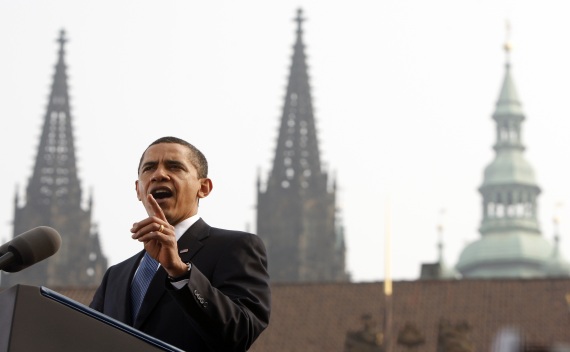Guest Post: Obama’s Nuclear Arms Control Agenda: Progress and Prospects
More on:

This is a guest post by CFR senior fellow Frank Klotz.
President Obama’s April 2009 speech in Prague won widespread acclaim for its commitment “to seek the peace and security of a world without nuclear weapons.” It also laid out a fairly specific agenda for moving toward that goal. Several “concrete steps” were proposed, including the completion of three major treaties: a new strategic arms control agreement with Russia, a global ban on nuclear tests, and a new treaty to cut off production of fissile materials for nuclear weapons.
The successful negotiation of the New Strategic Arms Reduction Treaty (New START) with Russia marked the first major accomplishment in this ambitious work plan. Almost immediately after its ratification by the Senate last December, senior Administration officials announced their intention to move out on the other steps outlined in the Prague speech, including pursuing even further reductions in strategic nuclear weapons and, for the first time, limits on tactical and non-deployed nuclear weapons.
Now, barely ten months later, several observers have taken the Obama Administration to task for supposedly making little progress on the Prague agenda. As The Atlantic recently reported, “many of those following weapons policy say Obama’s effort to begin reshaping the U.S.’s own massive nuclear arsenal in light of the zero goal has proceeded far more slowly than expected.”
In fact, U.S. arms control officials have been remarkably active on a number of different fronts. That’s certainly the impression Assistant Secretary of State Rose Gottemoeller conveyed last week in a speech to the First Committee of the U.N. General Assembly. Her wide-ranging account of ongoing arms control efforts belies the notion that the U.S. Administration has put the Prague agenda on pause.
With respect to further reductions in U.S. and Russian nuclear weapons, Gottemoeller noted that both the United States and NATO are currently examining their strategic requirements and options for the future. “While this work is proceeding,” she added, “the United States is ready for serious discussion with Russia of the conceptual, definitional and technical issues that will face us in the next phases of negotiation.”
Gottemoeller also reaffirmed that the Obama Administration remains committed to U.S. ratification of the Comprehensive Nuclear Test-Ban Treaty, which is key to the treaty entering into force on a global basis. The United States actually signed the CTBT during the Clinton Administration, but it has languished in political limbo ever since supporters failed to muster the necessary votes when the Senate considered it in 1999. Current Administration officials acknowledge that a renewed debate over CTBT will be “spirited, vigorous, and likely contentious,” and have not set a timeframe for a renewed bid for Senate ratification. For now, they are concentrating on laying the groundwork for a push when the time is right, emphasizing the non-proliferation merits of CTBT, as well as the steps taken to mitigate previously-expressed concerns about monitoring treaty compliance and ensuring the reliability of the U.S. nuclear weapon stockpile without full-scale testing.
Finally, Gottemoeller stated that the United States was eager to begin negotiations on a Fissile Material Cutoff Treaty, which has been an objective of the arms control community for years. U.S. officials have made no secret of their frustration with lack of progress within the Conference on Disarmament – the 65-member forum with responsibility for multilateral arms control and disarmament. While continuing to profess that the CD is the proper venue for negotiations on cut off treaty, the United States has joined in discussions with the “P5” group of declared nuclear powers on ways to encourage CD action during 2012.
Achieving a final agreement in any of these areas in the near term will be difficult. Fundamental differences remain between the United States and Russia on missile defense, tactical nuclear weapons, and conventional global strike weapons. Additionally, the current, highly-charged political atmosphere in Washington would certainly mean tough sledding for any new nuclear arms control initiative requiring Congressional approval, especially with attention now riveted on impending budget cuts and the 2012 election campaign beginning to heat up.
But, the reality is that arms control has almost always been a painstakingly slow process. The iconic nuclear arms control treaties of the Cold War era – SALT I, the INF Treaty, START I – took years to conclude, in some cases spanning more than one presidential term. Considerable effort and time were required to grind through countless arcane technical issues, and to satisfy disparate domestic constituencies. No one should ever expect quick results in the arms control business. Preparing the proverbial battlefield is an indispensable first step to success in any negotiation, and that takes a lot of hard work, persistence… and patience.
Frank Klotz is a Senior Fellow for Strategic Studies and Arms Control at the Council on Foreign Relations, and the former commander of Air Force Global Strike Command. While serving on the National Security Council staff from 2001 to 2003, he participated in negotiations leading to the Moscow Treaty.
More on:
 Online Store
Online Store